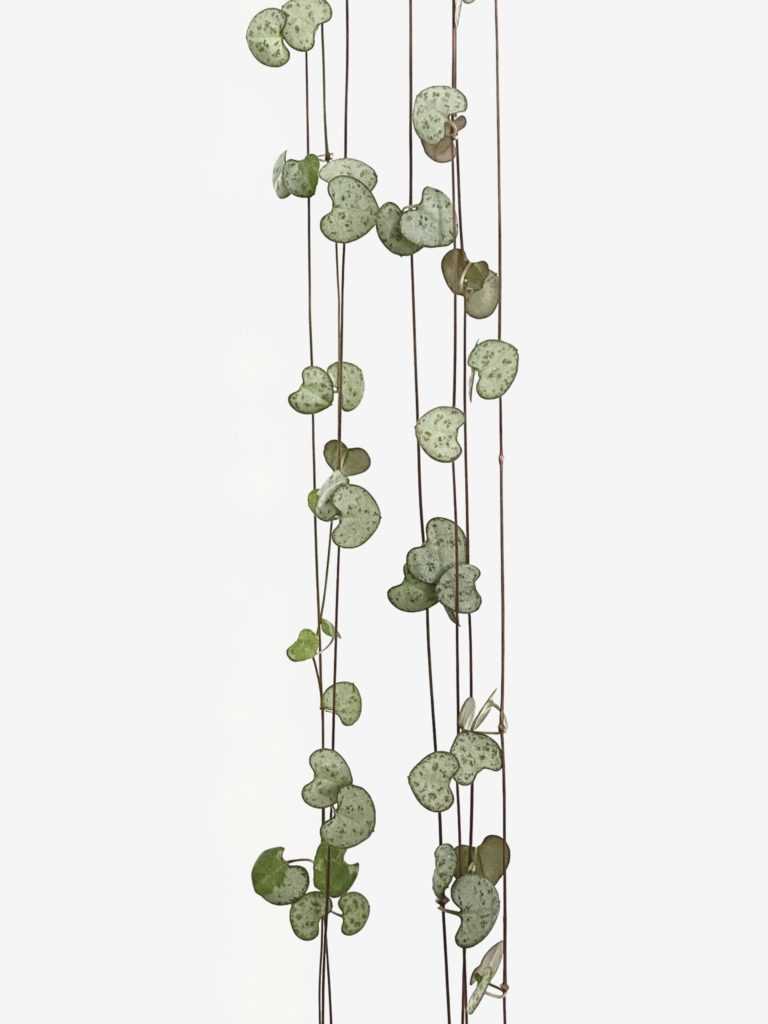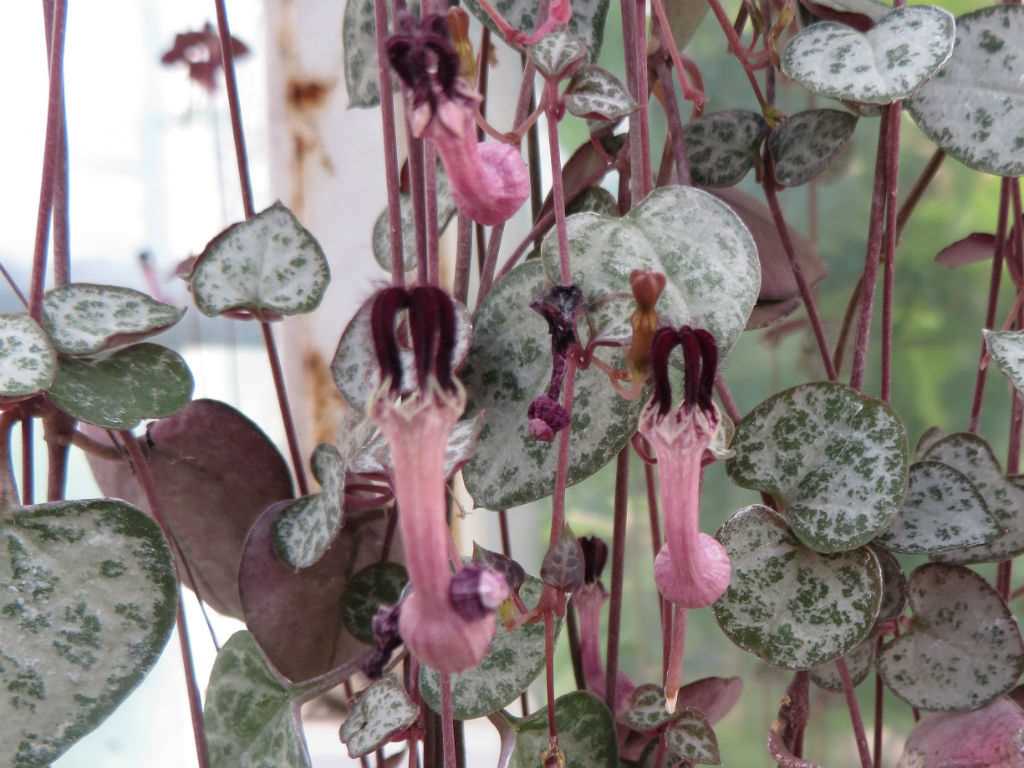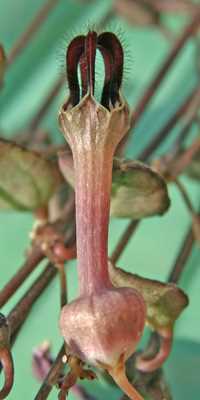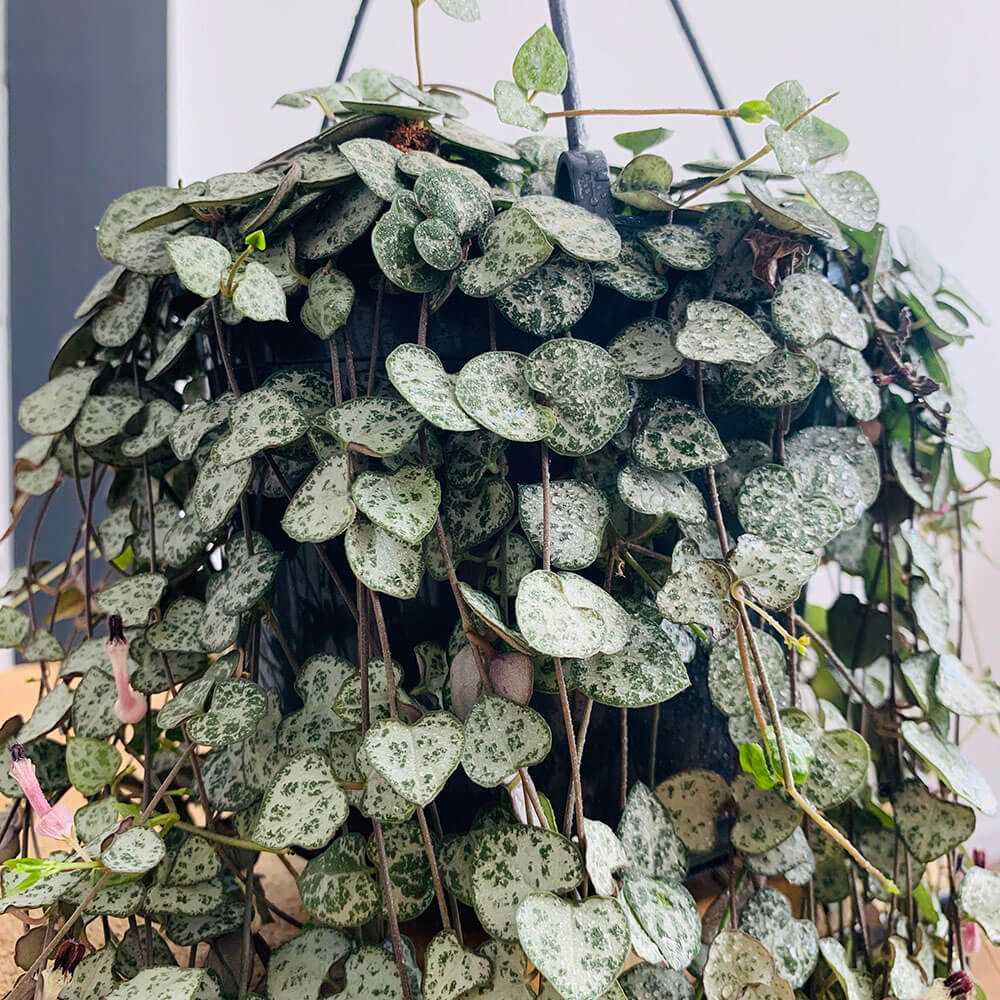- Choosing the Right Ceropegia Species for Your Home
- Light Requirements
- Watering Needs
- Temperature and Humidity
- Growth Habit
- Special Considerations
- Providing the Ideal Growing Conditions for Ceropegia Plants
- Light
- Temperature
- Humidity
- Watering
- Soil
- Fertilizer
- Propagation
- Watering and Feeding Ceropegia Plants: Dos and Don’ts
- Watering Dos:
- Watering Don’ts:
- Feeding Dos:
- Feeding Don’ts:
- Proper Potting and Repotting Techniques for Ceropegia Plants
- Choose the Right Pot
- Use Well-Draining Soil
- Gently Remove the Plant from its Current Pot
- Inspect and Trim the Roots
- Place the Plant in the New Pot
- Water and Monitor
- Pruning and Propagation: Key Steps for Healthy Ceropegia Plants
- 1. Pruning:
- 2. Propagation:
- 3. Maintenance:
- Common Pests and Diseases of Ceropegia: Prevention and Treatment
- Pests
- Diseases
- Prevention and Treatment
- Troubleshooting Common Issues in Ceropegia Care
- 1. Overwatering
- 2. Underwatering
- 3. Insufficient Light
- 4. Pests
- 5. Temperature and Humidity
- Decorating with Ceropegia Plants: Creative Ideas and Inspirations
- 1. Hanging Baskets
- 2. Wall-mounted Planters
- 3. Terrariums
- 4. Table Centerpieces
- 5. Bookshelf Display
- 6. Office Desk Plants
- 7. Hanging Plant Stands
- 8. Kitchen Herb Garden
- 9. Outdoor Hanging Planters
- 10. Tabletop Arrangements
- Q&A:
- How often should I water my Ceropegia plant?
- Should I fertilize my Ceropegia plant?
- Can I grow Ceropegia plants in direct sunlight?
- How do I propagate a Ceropegia plant?
- What should I do if my Ceropegia plant is not blooming?
- Video: learn from my mistakes! string of hearts/ceropegia care, collection, tips + tricks

Ceropegia is a genus of flowering plants in the family Apocynaceae, native to Africa, Asia, and Australia. These unique plants are known for their fascinating flowers and trailing vines, making them a popular choice for indoor gardening. With proper care and attention, you can successfully grow and nurture ceropegia plants in your own home.
One important aspect of caring for ceropegia plants is providing them with the right growing conditions. These plants thrive in bright, indirect light, so it’s best to place them near a window where they can receive plenty of sunlight without being exposed to direct sunlight. Additionally, ceropegia plants prefer slightly humid environments, so misting their leaves with water or placing them on a tray filled with pebbles and water can help maintain the desired humidity levels.
When it comes to watering ceropegia plants, it’s crucial to strike the right balance. These plants don’t like to be overwatered, so it’s important to let the top inch of soil dry out before watering again. However, you also don’t want the soil to become completely dry, as ceropegia plants prefer slightly moist conditions. It’s always best to err on the side of underwatering rather than overwatering, as excessive moisture can lead to root rot and other issues.
Ceropegia plants are generally easy to propagate through stem cuttings. Simply take a cutting from a healthy plant and place it in a pot filled with well-draining soil. Keep the soil slightly moist and place the cutting in a warm, bright location. Within a few weeks, you should start to see new roots forming, indicating that the cutting has successfully rooted. From there, you can continue caring for the new plant as you would any other ceropegia.
In conclusion, ceropegia plants are an excellent choice for indoor gardening. With their unique flowers and trailing vines, they add a touch of natural beauty to any space. By providing them with the right growing conditions, proper watering, and opportunities for propagation, you can ensure that your ceropegia plants thrive and flourish in your home.
Choosing the Right Ceropegia Species for Your Home
When selecting a Ceropegia plant for your home, it is important to consider the specific needs and requirements of different species. There are several types of Ceropegia plants, each with its own unique characteristics and care requirements. Here are some factors to consider when choosing the right Ceropegia species for your home:
Light Requirements
- Some Ceropegia species require bright, indirect light, while others can tolerate low light conditions.
- If you have a well-lit area in your home, you can opt for species that thrive in high light conditions.
- If your home has limited natural light, consider species that are more tolerant of lower light levels.
Watering Needs
- Certain Ceropegia species prefer to dry out between waterings, while others require consistently moist soil.
- If you tend to forget about watering your plants, choose a species that can tolerate some neglect.
- On the other hand, if you enjoy regular plant care, select a species that has higher watering needs.
Temperature and Humidity
- Some Ceropegia species prefer warm temperatures and high humidity levels, while others can tolerate cooler conditions.
- If you live in a cold climate or keep your home’s temperature low, opt for species that can thrive in cooler temperatures.
- If you live in a dry climate or struggle to maintain high humidity levels, choose species that are more tolerant of drier conditions.
Growth Habit
- Ceropegia plants come in various growth habits, including trailing, climbing, and bushy.
- Consider the available space in your home and the desired aesthetic when selecting a species with a specific growth habit.
- Trailing or hanging species can be a great choice for adding greenery to shelves, while climbing species can be trained on trellises or stakes.
Special Considerations
- Some Ceropegia species have specific care requirements, such as the need for well-draining soil or periodic misting.
- Take note of any special considerations or maintenance tasks associated with the species you choose.
- Research the specific needs of the species you are considering and ensure that you can provide the appropriate care.
By considering these factors and doing some research, you can choose the right Ceropegia species that will thrive in your home and bring beauty to your indoor space.
Providing the Ideal Growing Conditions for Ceropegia Plants
Creating the right growing conditions is crucial for the health and thriving of Ceropegia plants. By understanding their natural habitat and mimicking those conditions, you can ensure that your Ceropegia plants will flourish.
Light
Ceropegia plants prefer bright but indirect light. Placing them near a window that receives filtered sunlight or using sheer curtains to diffuse the light is ideal. Avoid exposing them to intense, direct sunlight as it can scorch their leaves.
Temperature
Ceropegia plants thrive in moderate temperatures between 65°F to 75°F (18°C to 24°C). They are not frost-tolerant and should be protected from cold drafts. It’s important to keep them away from air conditioning vents or heaters that may create extreme temperature fluctuations.
Humidity
These plants prefer moderate humidity levels. You can maintain humidity by placing a tray filled with water near the plant or by using a humidifier in the room. Avoid misting the leaves directly as it may lead to fungal diseases.
Watering
Ceropegia plants have moderate watering needs. Allow the top inch of soil to dry out between waterings and then water thoroughly, ensuring the excess water drains out. Overwatering can cause root rot, so it’s important to strike a balance and avoid letting the plants sit in water.
Soil


Ceropegia plants require well-draining soil to prevent waterlogging. A mix of potting soil and perlite or sand works well. This allows excess water to drain away while retaining enough moisture for the plant.
Fertilizer
During the growing season, fertilize your Ceropegia plants every two weeks using a balanced houseplant fertilizer. Dilute the fertilizer to half strength to prevent overfeeding, which can damage the plant.
Propagation
You can propagate Ceropegia plants through stem cuttings. Take a 3-4 inch cutting and remove the lower leaves. Allow the cutting to dry for a day or two before placing it in a well-draining potting mix. Keep the soil moist and provide the cutting with bright, indirect light until roots develop.
| Growing Conditions | |
|---|---|
| Light | Bright, indirect light |
| Temperature | 65°F to 75°F (18°C to 24°C) |
| Humidity | Moderate |
| Watering | Moderate; allow top inch of soil to dry out |
| Soil | Well-draining mix of potting soil and perlite/sand |
| Fertilizer | Every two weeks during the growing season |
| Propagation | Stem cuttings |
Watering and Feeding Ceropegia Plants: Dos and Don’ts
Proper watering and feeding are crucial for the health and growth of Ceropegia plants. Here are some dos and don’ts to keep in mind:
Watering Dos:
- Water your Ceropegia plants regularly to keep the soil moist but not soaked.
- Use well-draining soil to prevent water from sitting in the pot and causing root rot.
- Water the plants thoroughly, allowing the water to flow through the drainage holes of the pot.
- Monitor the moisture level of the soil using a moisture meter or by sticking your finger about an inch into the soil – if it feels dry, it’s time to water.
Watering Don’ts:
- Avoid overwatering your Ceropegia plants, as it can lead to root rot and other diseases.
- Do not let the plants sit in waterlogged soil, as this can suffocate the roots and lead to plant death.
- Avoid underwatering as well, as it can cause stress to the plants and hinder their growth.
Feeding Dos:
- Feed your Ceropegia plants with a balanced liquid fertilizer during the growing season.
- Follow the manufacturer’s instructions for the correct dosage and frequency of fertilization.
- Consider using a fertilizer high in phosphorus to promote blooming.
Feeding Don’ts:
- Avoid overfertilizing your Ceropegia plants, as it can lead to fertilizer burn and damage the roots.
- Do not feed the plants during their dormancy period or when they are showing signs of stress.
- Avoid using fertilizer that is not specifically formulated for houseplants, as it may contain ingredients that can be harmful to the plants.
By following these watering and feeding dos and don’ts, you can ensure that your Ceropegia plants thrive and remain healthy for years to come.
Proper Potting and Repotting Techniques for Ceropegia Plants
Proper potting and repotting are essential for the health and well-being of your Ceropegia plants. Here are some tips to help you pot and repot your Ceropegia plants successfully:
Choose the Right Pot


When potting or repotting your Ceropegia plant, it’s important to choose the right pot. The pot should be slightly larger than the current pot, allowing room for the roots to grow. It’s best to use a pot with drainage holes to prevent waterlogging and promote healthy root growth.
Use Well-Draining Soil


Ceropegia plants prefer a well-draining soil mix that retains some moisture but doesn’t trap water. You can use a mixture of potting soil, sand, and perlite to create a well-draining soil mixture. Avoid using heavy soils that hold onto water, as this can lead to root rot.
Gently Remove the Plant from its Current Pot
When repotting your Ceropegia plant, be gentle when removing it from its current pot. You can tap the sides of the pot to loosen the root ball, then gently pull the plant out. If the plant is root-bound, you may need to carefully loosen the roots with your fingers or a tool.
Inspect and Trim the Roots
Before repotting, inspect the roots of your Ceropegia plant. Look for any rotting or damaged roots and trim them off with clean gardening shears. Trimming the roots will encourage new and healthy root growth.
Place the Plant in the New Pot
Once you’ve prepared the new pot with well-draining soil, carefully place the Ceropegia plant in the center of the pot. Gently fill in the gaps with soil, ensuring that the roots are covered but not buried too deep. Avoid packing the soil too tightly, as this can restrict root growth.
Water and Monitor
After repotting, give your Ceropegia plant a thorough watering to settle the soil and help the roots establish themselves. Keep an eye on the plant over the next few days and adjust your watering schedule accordingly. Avoid overwatering, as this can lead to root rot.
Following these proper potting and repotting techniques will help ensure the health and vitality of your Ceropegia plants. Remember to monitor your plants regularly and make adjustments as needed to provide the best growing conditions.
Pruning and Propagation: Key Steps for Healthy Ceropegia Plants
Pruning and propagation are essential tasks for maintaining the health and promoting the growth of Ceropegia plants. Here are some key steps to follow:
1. Pruning:
- Regular pruning helps to shape the plant and remove any dead or damaged parts.
- Start pruning in early spring before new growth appears.
- Use sharp and clean pruning shears or scissors to make clean cuts.
- Remove any long and leggy stems to encourage bushier growth.
- Trim back any yellow or brown leaves to improve the overall appearance of the plant.
2. Propagation:
- Propagation is a great way to create new Ceropegia plants.
- Choose a healthy and mature plant for propagation.
- Locate the nodes on the stems, which are small bumps where leaves and stems meet.
- Using a sharp knife or scissors, cut a healthy stem just below a node.
- Remove any leaves from the lower part of the stem, leaving only a few at the top.
- Place the stem in a container filled with moist well-draining soil or in water.
- Keep the stem in a warm and bright location, avoiding direct sunlight.
- Within a few weeks, roots should begin to develop.
- Once roots have formed, transplant the new plant into a larger pot or garden bed.
3. Maintenance:
- Regularly check the soil moisture level and water the Ceropegia plant when the top inch of soil feels dry.
- Avoid overwatering, as it can lead to root rot.
- Apply a balanced liquid fertilizer every 2-4 weeks during the growing season to promote healthy growth.
- Monitor the plant for any signs of pests, such as mealybugs or spider mites, and take appropriate action if needed.
- Provide the plant with sufficient sunlight, as Ceropegia plants thrive in bright, indirect light.
- Rotate the plant occasionally to ensure even growth and prevent leaning towards the light source.
By following these pruning and propagation steps, you can ensure the health and vitality of your Ceropegia plants, allowing them to thrive and beautify your indoor or outdoor space.
Common Pests and Diseases of Ceropegia: Prevention and Treatment
Pests


- Aphids: These small insects feed on the sap of the Ceropegia plants and can cause stunted growth and discolored leaves. Use insecticidal soap or neem oil to control aphids.
- Spider mites: These tiny pests can cause yellowing leaves and webbing on the plant. Rinse the leaves with water to control spider mites, and use insecticidal soap if necessary.
- Mealybugs: Mealybugs are small, white insects that can infest ceropegia plants. They feed on the plant sap and can cause leaf drop. Use a cotton swab dipped in alcohol to remove mealybugs, and wash the plant with water and soap if the infestation is severe.
- Scale insects: Scale insects appear as small, oval bumps on the plant stems and leaves. They suck the sap from the plant, causing yellowing and wilting. Remove scale insects manually with a cotton swab dipped in alcohol.
Diseases
- Rhizoctonia root rot: This fungal disease affects the roots of ceropegia plants, causing rotting and wilting. To prevent root rot, avoid overwatering and make sure the soil is well-drained. If root rot occurs, remove the affected roots and replant the plant in fresh soil.
- Leaf spot: Leaf spot is a fungal disease that causes dark spots on the leaves of ceropegia plants. Remove the affected leaves and avoid overhead watering to prevent leaf spot. Fungicides can be used to control severe infections.
- Powdery mildew: Powdery mildew appears as a white powdery coating on the leaves of ceropegia plants. It can cause leaf distortion and stunted growth. Improve air circulation and reduce humidity to prevent powdery mildew. Fungicides can be used to control severe infections.
Prevention and Treatment
To prevent pests and diseases in ceropegia plants, it is important to provide them with proper care and maintenance:
- Keep the plants in well-draining soil and avoid overwatering to prevent root diseases.
- Check the plants regularly for signs of pests and diseases, and take necessary actions at the first sighting.
- Remove any affected leaves or parts of the plant to prevent the spread of diseases.
- Improve air circulation and reduce humidity to prevent fungal infections.
- Use organic insecticides or fungicides when necessary, following the instructions on the product.
By practicing good plant care and staying vigilant for any signs of pests or diseases, you can help your ceropegia plants stay healthy and thrive.
Troubleshooting Common Issues in Ceropegia Care
1. Overwatering
One of the most common issues with caring for Ceropegia plants is overwatering. These plants are adapted to survive in dry conditions, so excessive moisture can lead to root rot and other diseases.
Signs: Yellowing leaves, wilting, and mushy roots.
Solution: Allow the soil to dry out completely between waterings. Ensure that the pot has drainage holes to prevent water from pooling at the bottom.
2. Underwatering
On the other hand, underwatering can also be a problem for Ceropegia plants. Although they can tolerate dry conditions, they still require regular watering.
Signs: Drooping leaves, dry and brittle foliage, and stunted growth.
Solution: Water the plant thoroughly when the top inch of the soil feels dry. Ensure that the water reaches all the way to the roots.
3. Insufficient Light
Ceropegia plants thrive in bright, indirect light. Insufficient light can cause the plant to become leggy and have pale leaves.
Signs: Stretching stems, pale or bleached leaves, and slow growth.
Solution: Place your Ceropegia plant near a window where it can receive bright, indirect sunlight for at least a few hours each day. If natural light is limited, consider using a grow light.
4. Pests
Like any other houseplant, Ceropegia plants are susceptible to pests such as aphids, mealybugs, and spider mites.
Signs: Tiny insects on the leaves, sticky residue, and leaf damage.
Solution: Regularly inspect your plants for pests and treat them with an appropriate insecticide or horticultural soap. You can also use natural remedies like neem oil or a mixture of water and dish soap.
5. Temperature and Humidity
Ceropegia plants prefer warm temperatures and moderate humidity levels.
Signs: Leaf discoloration, wilting, and poor growth.
Solution: Keep the plant in a room with temperatures between 65-80°F (18-27°C). Increase humidity by misting the plant or placing it on a tray filled with water and pebbles.
By addressing these common issues, you can ensure that your Ceropegia plants grow healthy and thrive in your care.
Decorating with Ceropegia Plants: Creative Ideas and Inspirations
1. Hanging Baskets
One of the most popular ways to decorate with Ceropegia plants is by hanging them in baskets. The long, trailing stems of the plant make it an ideal choice for this type of display. Hang the baskets at varying heights to create an eye-catching arrangement in your space.
2. Wall-mounted Planters
If you’re short on floor or table space, consider using wall-mounted planters to showcase your Ceropegia plants. These planters can be easily attached to any wall, allowing you to bring greenery into even the smallest of spaces. Choose a variety of sizes and shapes to create a visually interesting display.
3. Terrariums
Ceropegia plants are the perfect choice for creating beautiful terrariums. The trailing vines of the plant look stunning when cascading down the sides of a glass container. Add some decorative elements like rocks, moss, or figurines to complete the look and create a miniature garden.
4. Table Centerpieces
Add a touch of greenery to your dining table or coffee table by using Ceropegia plants as centerpieces. Place them in decorative pots or vases and surround them with candles or other decorative elements. This will create a cozy and inviting atmosphere in your space.
5. Bookshelf Display
Showcase your Ceropegia plants on your bookshelf to add a pop of color and visual interest to your space. Mix different plant varieties together, and vary the heights to create a dynamic display. This will not only enhance the beauty of your plants but also add an aesthetic appeal to your bookshelf.
6. Office Desk Plants
Bring some life into your workspace by decorating your office desk with Ceropegia plants. Their low maintenance care requirements make them ideal for busy professionals. Place them in small pots or planters and position them strategically to create a calming and productive environment.
7. Hanging Plant Stands
For a unique and stylish way to display your Ceropegia plants, consider using hanging plant stands. These stands come in a variety of designs and materials, allowing you to find the perfect fit for your space. Hang them near windows or in empty corners to make a statement.
8. Kitchen Herb Garden
If you love cooking, why not have your own kitchen herb garden with Ceropegia plants? Plant herbs like basil, mint, or parsley alongside your Ceropegia plants to create a beautiful and functional display. Not only will you have fresh herbs at your fingertips, but you’ll also have a stunning green focal point in your kitchen.
9. Outdoor Hanging Planters
Take advantage of the trailing nature of Ceropegia plants by using them in outdoor hanging planters. Hang them from pergolas, trellises, or even tree branches to create a lush and vibrant outdoor space. Enjoy the beauty of these plants as they sway in the breeze.
10. Tabletop Arrangements
Create beautiful tabletop arrangements by combining your Ceropegia plants with other plants and flowers. Use a mixture of heights, colors, and textures to create a visually appealing display. These arrangements are perfect for special occasions or to add a touch of nature to your everyday life.
With these creative ideas and inspirations, you can make the most of your Ceropegia plants and bring their beauty into every corner of your home or office.
Q&A:
How often should I water my Ceropegia plant?
Ceropegia plants should be watered about once a week during the growing season, and less frequently during the winter months. It’s important to allow the soil to dry out between waterings to prevent root rot.
Should I fertilize my Ceropegia plant?
Yes, you should fertilize your Ceropegia plant during the growing season. Use a balanced, water-soluble fertilizer and follow the instructions on the packaging for proper dosage and application. Be sure to avoid over-fertilization, as it can lead to leaf burn.
Can I grow Ceropegia plants in direct sunlight?
Ceropegia plants prefer bright, indirect light. While they can tolerate some direct sunlight, too much can scorch the leaves. It’s best to place them in a location that receives bright, filtered light for a few hours each day.
How do I propagate a Ceropegia plant?
Ceropegia plants can be propagated through stem cuttings. Take a cutting with at least two leaf nodes, remove the lower leaves, and dip the end in rooting hormone. Plant the cutting in a well-draining soil mix and keep it in a warm, humid environment until roots develop.
What should I do if my Ceropegia plant is not blooming?
If your Ceropegia plant is not blooming, it may not be receiving enough light or the right environmental conditions. Make sure it’s getting enough bright, indirect light and adjust its position if needed. Additionally, ensure that it’s not overwatered and that the temperature and humidity levels are suitable for its growth.
Video:
learn from my mistakes! string of hearts/ceropegia care, collection, tips + tricks







